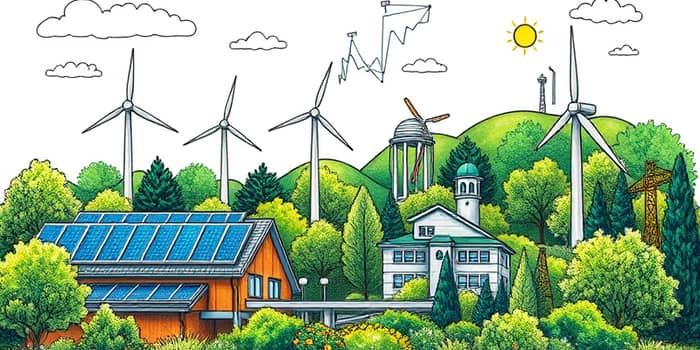
In an era marked by environmental urgency and economic transformation, green bonds have emerged as a cornerstone of sustainable finance. These instruments bridge the gap between capital markets and climate action, offering investors a tangible way to back projects that safeguard our planet’s future. As we navigate a world grappling with rising temperatures, resource constraints, and social inequities, green bonds stand out as a beacon of hope—powering renewable energy, low-carbon infrastructure, and resilient communities.
At their essence, green bonds are fixed-income instruments tailored to raise capital for environmentally friendly projects. Unlike traditional bonds, proceeds from these offerings are earmarked for ventures that advance climate change mitigation and adaptation. Issuers span governments, development banks, municipalities, corporations, and financial institutions, all united by a common goal: channeling funds into renewable energy, sustainable transport, energy efficiency, and nature-based solutions.
This clear allocation of proceeds not only offers investors financial returns but also ensures that every dollar contributes to measurable environmental outcomes. Third-party verification and certification frameworks lend credibility, reinforcing trust and combating greenwashing—false claims of environmental benefit.
The green bond market has witnessed exponential growth since its inception. From a modest $11 billion in labeled issuances in 2012, the sector soared past $150 billion in 2017, reflecting a burgeoning appetite for sustainable assets. By 2025, estimates place the market between USD 526.8 billion and 670 billion, with projections to surpass USD 1.03–1.05 trillion by 2030.
Such robust expansion corresponds to a compound annual growth rate (CAGR) ranging from 7.8% to 10.9% between 2025 and 2032. In the broader sustainable bond landscape, green bonds dominate, expected to account for $620 billion of issuance in 2025.
Issuance has diversified rapidly. Sovereign and municipal governments lead alongside supranational bodies and development banks, joined by major corporations like Apple Inc., Bank of America, JP Morgan Chase, Barclays, and Citigroup. On the investor side, public pension funds, asset managers, insurance companies, and retail investors embrace green bonds to align portfolios with environmental, social, and governance principles.
Corporate issuers leverage green bonds to finance specific projects, enhancing their sustainability credentials and often receiving favorable market reactions. Meanwhile, development finance institutions use them to unlock private capital for emerging markets, where infrastructure needs coincide with preservation goals.
The green bond market is truly global, yet certain regions stand out. In 2025, the Asia Pacific is projected to hold the largest market share, driven by populous countries investing heavily in renewable energy and urban resilience. North America, meanwhile, is anticipated to record the fastest growth rate between 2025 and 2030, fueled by supportive federal guidelines and a surge in state-level green initiatives.
Europe has long been a pioneer, with the European Investment Bank playing a foundational role. Together, these regions shape regulatory norms, reporting standards, and market best practices, fostering a competitive yet collaborative environment.
Several factors have propelled green bond adoption:
These dynamics create a virtuous cycle: successful issuances inspire newcomers, while standardized guidelines and greater liquidity attract mainstream investors.
Real-world examples underscore the transformative power of green bonds. A technology giant’s issuance to fund solar farms led not only to a reduction in carbon emissions but also to a positive stock market response. Similarly, municipal green bonds have financed public transit upgrades, slashing urban emissions and enhancing quality of life.
Investors benefit from stable coupon payments and portfolio diversification, while communities gain resilient infrastructure. Measuring impact—from megawatts of renewable energy generated to hectares of restored wetlands—reinforces accountability and drives continuous improvement.
Despite impressive strides, challenges persist. Standardization remains a key hurdle: without uniform definitions of ‘green,’ issuers risk inconsistency. Varying reporting requirements can increase administrative burdens, raising issuance costs—especially for smaller entities.
Market liquidity, though improving, lags behind conventional bonds. To address these issues, participants advocate for:
By tackling these barriers, the market can scale more efficiently and inclusively.
Innovation continues to invigorate the green bond space. Blockchain and digital finance platforms streamline issuance, tracking, and trading, reducing costs and improving transparency. The rise of digital green bonds promises near-instant settlement and enhanced traceability of fund flows.
Moreover, the scope of eligible projects is broadening. Beyond renewable energy and efficiency upgrades, investors increasingly back nature-based solutions, climate adaptation measures, and social co-benefits. This holistic approach aligns with stakeholder expectations and the complex realities of global sustainability challenges.
Looking ahead, the green bond market’s trajectory remains upward. As governments recommit to net-zero targets and private sector leaders integrate sustainability into core strategies, demand for green financing will intensify. Innovation in product design—such as transition bonds for heavy industries—will attract new issuers and investors.
Key opportunities include:
By embracing these avenues, stakeholders can ensure that green bonds remain at the forefront of climate finance, catalyzing a rapid shift toward a low-carbon economy.
Green bonds have transcended their role as niche instruments to become a central pillar of sustainable markets. With robust growth forecasts, diverse issuer participation, and innovative technologies, they offer a powerful mechanism to tackle climate change while delivering financial value.
As investors, policymakers, and communities align around shared environmental goals, green bonds will continue to evolve—expanding their impact and reshaping global finance. In doing so, they illuminate a path toward a more resilient, equitable, and verdant future for generations to come.
References













